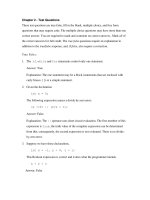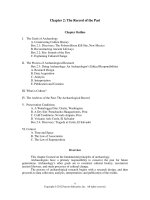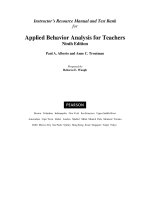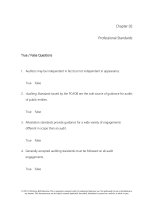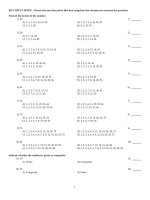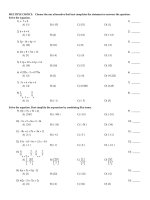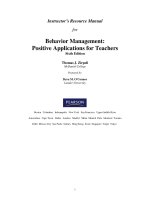Human relations strategies for success 5th edition lamberton test bank
Bạn đang xem bản rút gọn của tài liệu. Xem và tải ngay bản đầy đủ của tài liệu tại đây (302.93 KB, 49 trang )
Chapter 02
Self-Concept and Self-Esteem in Human Relations
True / False Questions
1.
Self-esteem is the way you conceive of or see yourself.
True
2.
False
To minimize the effects of the vicious cycle of negative self-concept leading to negative behavior,
you must analyze who started the cycle.
True
3.
Ideal self is your vision of your future self.
True
4.
False
False
Parents who present their children with a picture of how the children must act to win approval are
said to hold "conditional positive regard" for their children.
True
5.
False
Self-image is the self that you assume others see when they look at you.
True
False
2-1
Copyright © 2015 McGraw-Hill Education. All rights reserved. No reproduction or distribution without the prior written consent of
McGraw-Hill Education.
6.
The looking-glass self is affected by your view of reality.
True
7.
Self-image can be programmed by the things you say to yourself or others.
True
8.
False
The process of discovering your looking-glass self is known as developing your self-awareness.
True
9.
False
False
Having a healthy self-concept means not allowing yourself to be a slave to other people's
opinions.
True
False
10. Self-esteem can be defined as the extent to which an individual believes him- or herself to be
capable, sufficient, and worthy.
True
False
11. Most people who always need to tell about their accomplishments are actually compensating in
some way for low self-esteem.
True
False
12. Focusing on a single strength to compensate for overall bad feelings about oneself is a good way
to build higher self-esteem.
True
False
2-2
Copyright © 2015 McGraw-Hill Education. All rights reserved. No reproduction or distribution without the prior written consent of
McGraw-Hill Education.
13. People with low self-esteem can more readily accept their co-workers and take criticism from
others in their work teams.
True
False
14. Children are most likely to develop a healthy self-esteem when parents show "conditional positive
regard" toward them.
True
False
15. According to psychologist Carl Rogers, the sense of self is a guiding principle that structures the
personality.
True
False
16. During childhood, parents are the most important people among those shaping self-esteem.
True
False
17. According to Alfred Adler, the main motivation for everything people do, including efforts toward a
successful career, is to get away from a deep childhood-based feeling that they are not as good as
they should be.
True
False
18. Locus of control is the perceived center of control over the events in people's lives.
True
False
19. People with an external locus of control believe that they have control over the events in their lives.
True
False
2-3
Copyright © 2015 McGraw-Hill Education. All rights reserved. No reproduction or distribution without the prior written consent of
McGraw-Hill Education.
20. When Delilah got a D grade in one of her papers, she said to herself, "I should have studied instead
of watching movies all night long with my friends; I'll do better next time." From this comment we
can conclude that Delilah has an external locus of control.
True
False
21. Putting things off for too long and not working toward goals can bring your self-esteem even
lower.
True
False
22. The fear of pain encourages people to avoid procrastinating things for too long.
True
False
23. True mentoring involves two people communicating well, one mostly teaching and the other
mostly learning.
True
False
24. A role model typically acts as a guide or teacher for a person, actively interacting with the person
and leading that person through experiences.
True
False
25. Positive self-talk leads to a low self-esteem.
True
False
26. Positive self-talk means telling your subconscious mind that you are a good person and doing fine.
True
False
2-4
Copyright © 2015 McGraw-Hill Education. All rights reserved. No reproduction or distribution without the prior written consent of
McGraw-Hill Education.
27. The self-fulfilling prophecy refers to the tendency for a prediction to actually occur once it is
believed.
True
False
28. While forming affirmations for positive self-talk, you should be general, rather than specific.
True
False
29. Self-fulfilling prophecies can come from your "buy-in" or taking as fact the beliefs that others hold
about you.
True
False
30. The stronger or higher a person's self-esteem is, the weaker the effect other people's negative
statements will have on his or her behavior.
True
False
Multiple Choice Questions
31. Which of the following statements is true about self-concept?
A. It is the tendency to turn an irrational belief into an imagined disaster for yourself.
B. It is the power that is based on your attractiveness to others.
C. It is the power that depends on the threat of possible punishment.
D. It is the foundation of all your thoughts about yourself.
2-5
Copyright © 2015 McGraw-Hill Education. All rights reserved. No reproduction or distribution without the prior written consent of
McGraw-Hill Education.
32. Seeing yourself as being efficient in a particular field is an example of:
A. cognitive dissonance.
B. self-concept.
C. self-disclosure.
D. self-effacing.
33. Sarah's manager had given her feedback on her low performance for the quarter. She internalized
the manager's observation and started thinking of herself as an unprofessional and inefficient
employee. This lowered her ____, and she tended to be even less productive than before. This led to
a vicious cycle.
A. locus of control
B. self-awareness
C. social competence
D. self-concept
34. Which of the following will be the most constructive way of behaving if you are stuck in a vicious
cycle of negative self-concept leading to negative actions and vice versa?
A. Trying to analyze who started the cycle
B. Establishing an external locus of control
C. Examining ways to stop the cycle
D. Providing conditional positive regard
2-6
Copyright © 2015 McGraw-Hill Education. All rights reserved. No reproduction or distribution without the prior written consent of
McGraw-Hill Education.
35. How would all the four parts of self-concept occur in a perfect world?
A. All the four parts would intersect each other.
B. All the four parts would be one single circle.
C. The real self and looking-glass self would be separate from each other.
D. The ideal self and self-image would be distinct from each other.
36. Everyone has some notion of what he or she would like to become. This vision is known as one's:
A. real self.
B. looking-glass self.
C. ideal self.
D. self-image.
37. John is an introvert and a pessimist. He hopes to become an optimist and a more sociable person
someday. This happy and positive person that John wants to be is his:
A. real self.
B. ideal self.
C. self-image.
D. looking-glass self.
38. What is a common mistake that people make about their ideal self?
A. Most people create an unrealistic and unattainable picture of their ideal self.
B. Many people have an unclear picture of their ideal self.
C. For most people the ideal self is much more negative than it deserves to be.
D. Most people do not know that they have already reached their ideal self.
2-7
Copyright © 2015 McGraw-Hill Education. All rights reserved. No reproduction or distribution without the prior written consent of
McGraw-Hill Education.
39. Which of the following statements is true about conditional positive regard?
A. It leads to the realization that knowing and taking care of the "real you" is quite possible without
threatening others.
B. It helps the children to achieve their goals and increase their level of happiness.
C. It is an assumption of most people that others think well of them much more than is true.
D. It may lead to the children growing up either rejecting the parents' plans for them completely or
becoming depressed and giving up.
40. Which of the following best describes the looking-glass self?
A. It is the knowledge of how you are being perceived by others.
B. It is the self you assume others see when they look at you.
C. It is the way you truly feel about yourself.
D. It is the manner in which you behave when no one is around.
41. Which of the following statements is true of your self-image?
A. It can be programmed by your day-to-day behavior.
B. It is not affected by the things you say to yourself.
C. It is the way you actually are when nobody is around.
D. It is the self you assume others see when they look at you.
2-8
Copyright © 2015 McGraw-Hill Education. All rights reserved. No reproduction or distribution without the prior written consent of
McGraw-Hill Education.
42. Your _____ is the way you truly feel about yourself.
A. self-image
B. ideal self
C. ego
D. looking-glass self
43. Developing your self-awareness is typically a process of:
A. giving positive self-suggestions.
B. establishing an external locus of control.
C. assuming a more positive looking-glass self.
D. discovering your real self.
44. What is a real self?
A. The way you actually are when nobody is around
B. The vision of your future self
C. The self that is based on the conditional positive regard
D. The way you truly feel about yourself
2-9
Copyright © 2015 McGraw-Hill Education. All rights reserved. No reproduction or distribution without the prior written consent of
McGraw-Hill Education.
45. In the context of Carl Rogers's theory, which of the following statements is true about selfconcept?
A. The main motivation for everything you do, is to get away from a deep childhood-based feeling
that you are not as good as you should be.
B. Your internal locus of control is related to both higher self-esteem and better physical health.
C. Your ideal self comes from the messages you receive from your parents and people around you
about what you should be like.
D. You develop internal or external explanations for control based on experiences.
46. Danica wants to excel as a student. However, she gets a D in her term exam. This shows:
A. the distance between Danica's real self and ideal self.
B. that Danica's looking-glass self is more positive than it deserves to be.
C. that Danica's ideal self and her self-image do not match.
D. the distance between Danica's looking-glass self and ideal self.
47. According to Carl Rogers, how can one bring the ideal self and the real self closer to develop a
healthy self-concept?
A. By adjusting the real self to fit the looking-glass self
B. By working up to a more realistic and attainable ideal
C. By adjusting the ideal self according to the messages received from the environment
D. By paying more attention to the messages about one's ideal self
2-10
Copyright © 2015 McGraw-Hill Education. All rights reserved. No reproduction or distribution without the prior written consent of
McGraw-Hill Education.
48. People sometimes find it difficult to be around those who really don't "need" anyone to like them
because:
A. they derive their purpose from displeasing others.
B. they typically receive unconditional positive regard.
C. they have an internal locus of control.
D. they expect others to share their need for acceptance.
49. What is self-esteem?
A. It is the regard in which you hold yourself.
B. It is invariably the same as the self-concept.
C. It is what you assume others see when they look at you.
D. It is the way you truly are when nobody is around to approve of your actions.
50. Which of the following best describes the act of compensating?
A. It is the practice of acting ethically while understanding your actions are part of the larger,
interactive picture of your workplace, community, and world.
B. It is the practice of focusing on a single strength to make up for the real or perceived
weaknesses.
C. It is the practice of presenting a more positive real self to make up for a negative looking-glass
self.
D. It is the practice of allowing people to more readily accept their co-workers and take criticism
from them.
2-11
Copyright © 2015 McGraw-Hill Education. All rights reserved. No reproduction or distribution without the prior written consent of
McGraw-Hill Education.
51. Lena, a former sprint runner, boasts about her speed and how she had surpassed her competitors
in her prime days. Though she has not been in the best of shape for the last few years, she
continues to talk about her fitness. Lena is trying to:
A. pay more attention to the messages she is receiving from her environment.
B. use a self-suggestion technique to improve her self-esteem.
C. discover her real self.
D. compensate in some way for her low self-esteem.
52. People who have high self-esteem are more likely to succeed in achieving their personal goals
because:
A. they are motivated by a need to compensate through achievement.
B. they are driven by a desire to see their dreams and goals achieved.
C. they focus their energies on a single strength to make up for their overall weaknesses.
D. they work hard to measure up to others' achievements and goals.
53. In an organizational context, which of the following is true of people with low self-esteem?
A. They are more likely to work with little enthusiasm or commitment.
B. They readily accept criticism from others in the team.
C. They are objective while tackling a problem.
D. They usually receive unconditional positive regard from their colleagues.
2-12
Copyright © 2015 McGraw-Hill Education. All rights reserved. No reproduction or distribution without the prior written consent of
McGraw-Hill Education.
54. Self-efficacy is the:
A. use of a single strength to make up for a real or perceived weakness.
B. individual's vision of his or her future self.
C. way an individual conceives or sees himself or herself.
D. confidence an individual has in his or her ability to deal with problems.
55. Which of the following is a source of self-esteem?
A. The messages we receive from our parents and others around us
B. The ideal self that we have
C. The external locus of control that we develop during our childhood
D. The emotional problems that we need to attend to
56. How did Carl Rogers revolutionize the way psychologists thought of therapy?
A. He developed theories about the inferiority complex and about compensation for feelings of
deficiency compared with others.
B. He believed clients understood their own problems and experiences, and that the therapist's role
was that of a consultant in assisting client treatment.
C. He refined social learning theory to say that personality comes from an interaction of the
individual with his or her environment.
D. He developed the theory of the self-fulfilling prophecy.
2-13
Copyright © 2015 McGraw-Hill Education. All rights reserved. No reproduction or distribution without the prior written consent of
McGraw-Hill Education.
57. What is unconditional positive regard?
A. The acceptance of individuals as worthy when they behave in a certain way.
B. The acceptance of individuals as worthy and valuable regardless of their behavior.
C. The attempt by parents to improve their children's behavior by comparing them to others.
D. The rejection of children by their parents as inherently worthless unless otherwise proven by
their behavior.
58. How does conditional positive regard affect children?
A. Children may develop an unattainable real self.
B. Children will develop an external locus of control.
C. Children may become confused on what constitutes good or bad behavior.
D. Children will never try to measure up to others' standards.
59. _____ coined the term inferiority complex.
A. Carl Rogers
B. Julian Rotter
C. Eric Bern
D. Alfred Adler
60. Which of the following is the most effective self-esteem affirmation?
A. "I want to be a great success."
B. "I am responsible for my own choices."
C. "I do not like myself and anyone around me."
D. "I want to be a good person."
2-14
Copyright © 2015 McGraw-Hill Education. All rights reserved. No reproduction or distribution without the prior written consent of
McGraw-Hill Education.
Fill in the Blank Questions
61. _____ is the foundation of all your thoughts about yourself, including your self-esteem.
________________________________________
62. Some parents present their children with a picture of how the children must act to win approval.
Such parents are said to hold ____.
________________________________________
63. The _____ self is the self that you assume others see when they look at you.
________________________________________
64. _____ is the way you honestly feel about yourself.
________________________________________
65. The process of discovering your _____ is known as developing your self-awareness.
________________________________________
66. According to Carl Rogers, your _____ comes from the messages you receive from your parents and
people around you about what you should be like.
________________________________________
2-15
Copyright © 2015 McGraw-Hill Education. All rights reserved. No reproduction or distribution without the prior written consent of
McGraw-Hill Education.
67. Carl Rogers believed that in order to have a healthy ____, people need to work on making the ideal
and real selves much closer.
________________________________________
68. _____ occurs when individuals are unable to see themselves as capable, sufficient, or worthy.
________________________________________
69. Psychological research finds that people with _____ self-esteem often feel self-conscious and
vulnerable to rejection.
________________________________________
70. _____ is associated with low job satisfaction and has even been linked to a higher likelihood of
unemployment.
________________________________________
71. When people with a(n) _____ self-esteem tackle problems, they tend to be more objective and
constructive.
________________________________________
72. _____ is the confidence an individual has in his or her ability to deal with problems when they occur.
________________________________________
73. Self-esteem starts to develop in _____ from messages we receive from parents and others around
us.
________________________________________
2-16
Copyright © 2015 McGraw-Hill Education. All rights reserved. No reproduction or distribution without the prior written consent of
McGraw-Hill Education.
74. The acceptance of individuals as worthy and valuable regardless of their behavior is referred to as
____.
________________________________________
75. When parents show children _____ then children may not develop a healthy self-esteem.
________________________________________
76. When your parents and other important people treat you with ____, then you are likely to develop a
healthy self-esteem.
________________________________________
77. Alfred Adler believed that the main motivation for everything people do, including efforts toward a
successful career, is to get away from a(n) _____ that they are not as good as they should be.
________________________________________
78. People with a(n) _____ locus of control feel that they are in control of events in their own lives and
have more of a take-charge attitude.
________________________________________
79. People with a(n) _____ locus of control feel that the world is happening to them, and that they have
no control over the events in their lives.
________________________________________
2-17
Copyright © 2015 McGraw-Hill Education. All rights reserved. No reproduction or distribution without the prior written consent of
McGraw-Hill Education.
80. A(n) _____ is someone who will walk you through experiences that are new to you, but that he or
she has already been through.
________________________________________
Short Answer Questions
81. How does one's self-concept lead to a vicious cycle?
82. List two common mistakes people make about their ideal self?
2-18
Copyright © 2015 McGraw-Hill Education. All rights reserved. No reproduction or distribution without the prior written consent of
McGraw-Hill Education.
83. How do the things that you say affect your self-image?
84. What happens when the ideal self and the real self are not close to each other?
85. In the context of Mary Pipher's studies, explain how media messages affect young girls growing up
in America.
2-19
Copyright © 2015 McGraw-Hill Education. All rights reserved. No reproduction or distribution without the prior written consent of
McGraw-Hill Education.
86. Why is liking and accepting yourself the most important skill you can learn in life?
87. Why do some people brag about themselves?
88. How does a person with high self-esteem perform at his or her workplace?
2-20
Copyright © 2015 McGraw-Hill Education. All rights reserved. No reproduction or distribution without the prior written consent of
McGraw-Hill Education.
89. Describe the two types of self-esteem.
90. In the context of Carl Roger's studies, explain the source of self-esteem?
91. How does conditional positive regard affect children?
2-21
Copyright © 2015 McGraw-Hill Education. All rights reserved. No reproduction or distribution without the prior written consent of
McGraw-Hill Education.
92. What did Alfred Adler discover about conditional positive regard?
93. If a student who failed in an exam has an external locus of control, how would he or she respond to
the failure?
94. How does reading biographies of people you admire help you achieve higher self-esteem?
2-22
Copyright © 2015 McGraw-Hill Education. All rights reserved. No reproduction or distribution without the prior written consent of
McGraw-Hill Education.
95. How will procrastination affect an individual?
96. Describe a mentor.
97. What is the difference between a role model and a mentor?
2-23
Copyright © 2015 McGraw-Hill Education. All rights reserved. No reproduction or distribution without the prior written consent of
McGraw-Hill Education.
98. List the benefits of positive self-talk.
99. Why are self-esteem affirmations effective?
100. What is a pathological critic?
2-24
Copyright © 2015 McGraw-Hill Education. All rights reserved. No reproduction or distribution without the prior written consent of
McGraw-Hill Education.
Chapter 02 Self-Concept and Self-Esteem in Human Relations Answer Key
True / False Questions
1.
Self-esteem is the way you conceive of or see yourself.
(p. 28)
FALSE
2.
To minimize the effects of the vicious cycle of negative self-concept leading to negative
(p. 28)
behavior, you must analyze who started the cycle.
FALSE
3.
Ideal self is your vision of your future self.
(p. 28)
TRUE
4.
Parents who present their children with a picture of how the children must act to win approval
(p. 29)
are said to hold "conditional positive regard" for their children.
TRUE
5.
Self-image is the self that you assume others see when they look at you.
(p. 29)
FALSE
2-25
Copyright © 2015 McGraw-Hill Education. All rights reserved. No reproduction or distribution without the prior written consent of
McGraw-Hill Education.
